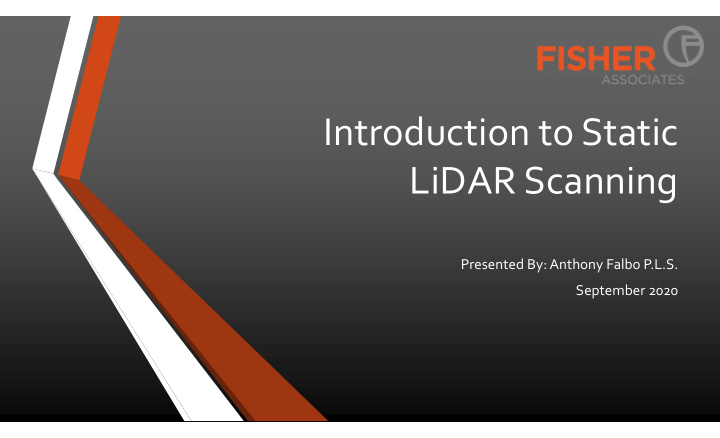



Introduction to Static LiDAR Scanning Presented By: Anthony Falbo P.L.S. September 2020
LiDAR Scanning Overview • Scanning background • Applications • Strengths • Weaknesses • Scanning Examples Fisher Associates
LiDAR = light detecting and ranging
Types of Scanners • Terrestrial: • Airborne Mobile Ground LiDAR Aerial Platform LiDAR Used by autonomous vehicles Cars/boats Static LiDAR Set up on tripod
Airborne Scanners Mobile Terrestrial Scanners Gmv.cast.uark.edu Techcrunch.com
Static Terrestrial Scanners Researchgate.net
Applications • Land Surveying/Civil Engineering • Geological/Ecological Monitoring • City Planning • Architecture • Archaeology • Crime Scene Preservation (Forensic) • Video Gaming
Land Survey & Engineering • Structure or Site monitoring • Retaining walls • Pavement • Bridges • As-Built Surveys • Historical Preservation • Interior and exterior of structures
Geological & Ecological Monitoring • Mining • Monitor unlined tunnel • Monitor for support structure deformation • Analyze hard to reach rock structures • Slope monitoring • Measure leaf density of vegetation • Capture existing stream bank conditions
Survey Control • Establish survey control Network of control points – known coordinates • Can provide different coordinate systems depending on need Tied to survey control by spheres and checkered scan targets
Workflow (cont.) Office • Process and adjust point cloud Before • Classify the point data Classification Most scan processing software with image automatically classifies or moves overlay. like points to specific feature layers
Workflow (cont.) • Further review of layers is required • Create classification layers and classify as necessary After classification
Fisher Scanning Examples • Marcy Pedestrian Bridge Forensic Survey
Fisher Scanning Examples (cont.) • Calspan Helium Tank As-Built Survey
Fisher Scanning Examples (cont.) • Thurston Avenue Bridge Topographic Survey
Scanning Examples (cont.) • Exposed Slide Scan (by others)
Strengths • Assurance Scan data is adjusted to survey control after scans are registered • Safety Capture valuable data in areas where field crews may not be able to reach Elevated platforms, confined spaces, busy roadways, etc. • Thorough Generally, no bad shots on break lines or missed features • Superior to traditional surveying for volume surveys Gets all bulges and voids More accurate with dense point clouds. • Reduces 2nd trips Point data extends beyond area of interest (data in the can) Able to pick additional features from point cloud
Weaknesses • Reflective Surfaces • Snow • Rain • Vegetation • More labor intensive in the office, although, the time balances out.
Questions?
Sources • http://floridalaserscanning.com/3d-laser-scanning/how-does-laser- scanning-work/ • https://www.spar3d.com/news/related-new-technologies/time-of-flight-vs- phase-based-laser-scanners-right-tool-for-the-job/ • https://www.researchgate.net/figure/Basic-types-of-terrestrial-3D-laser- scanners-TLS-a-brief-overview-A-Faro-Focus_fig3_322096576 • https://www.pobonline.com/articles/101884-lidar-use-rising-among- surveyors?page=2
Recommend
More recommend